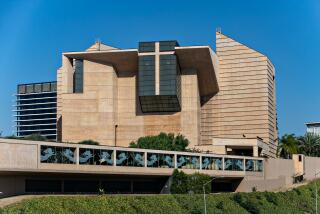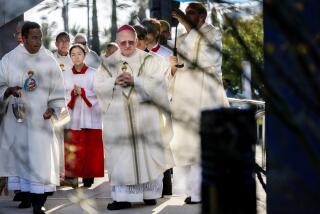Father Serra’s Remains Exhumed on the Complex Road to Sainthood
CARMEL — Officials of the Roman Catholic Church have exhumed the 200-year-old remains of Father Junipero Serra as part of the complex process that may result in sainthood for the Franciscan missionary known as “the apostle of California.”
Serra, who founded this mission in 1771 and died here in 1784, was declared “venerable,” the first of three steps to sainthood, by Pope John Paul II in 1985. It was widely expected that the Pope would declare Serra “beatified,” the second step, when he visited Serra’s grave--below the stone floor of the Carmel Mission Basilica, in front of the altar--on Sept. 17 of this year.
However, shortly before the Pope left for the United States, the Vatican announced that the Congregation for the Causes of Saints had been unable to complete the investigation of Serra’s “cause,” as it is known.
Praised as Evangelist
In both Phoenix and Carmel, the Pope lauded Serra’s work as an evangelist and as the founder of nine missions between San Diego and San Francisco, despite some protests from American Indians who charged that Serra oversaw a system that physically and culturally annihilated California Indians.
The exhumation is formally known as “canonical recognition,” and is “usually done just before beatification,” according to Msgr. Robert Sarno, an American priest serving in the congregation.
Its purpose is twofold, Sarno said in an interview from Rome. In the event of beatification, he said, worshipers will want to come and pray at the grave of the individual and the church wants to be certain that the remains are those of that individual. Actually, there is very little doubt as to the identity of the remains. In 1943, for archeological and canonical purposes, the Vatican permitted an exhumation of all three of the vaults in the front of the basilica.
Pieces of Bone
In addition, Sarno said, some bone fragments are removed to be encased in glass and to be used as objects of veneration, Sarno said.
In 1943, with the doors of the basilica locked, the exhumation began with an “oath of fidelity and secrecy” administered by a priest. In the middle vault, as indicated by engraved stones, were found the remains of Serra in a redwood coffin, alongside the remains of Father Juan Crespi, Serra’s longtime associate.
Physicians and forensic anthropologists, including several on loan from the Army, were able to confirm the identify of Serra’s remains by comparing bone measurements to information listed on Serra’s Spanish passport and anecdotal material recorded about him by fellow priests.
Special Coffin Used
In 1943, after several months of excavation and examination, Serra was reburied alone in the middle vault in a copper coffin with an air-tight glass inner lid. (Crespi’s remains were buried in another vault.) The coffin was sealed with brass wire and marked with crosses and images of the Virgin Mary.
Bishop Thaddeus Shubsda of Monterey declined all comment on Friday’s exhumation “following a letter of instruction from the Vatican.”
Workers began opening the vault Thursday afternoon, working until nearly midnight, when the coffin was removed from the vault, according to a source who asked that he not be identified. The coffin was opened and the examination begun again Friday morning. It was completed by 2 p.m.
Numerous Witnesses
Present for Friday’s exhumation were Shubsda, Msgr. Francis J. Weber, archivist of the Los Angeles Diocese; Father Francis Guest, head of the archives at Mission Santa Barbara; Father Noel Francis Moholy, chief backer of Serra’s cause in the United States, several other priests, two physicians and six workers.
The doors to the basilica were locked Friday and posted with signs reading “Closed For Construction,” as the usual stream of tourists ducked in and out of intermittent rainstorms throughout the mission complex.
Prayers were recited at the beginning and the end of the exhumation. Several ounces of bone fragments were removed.
“Today was simple,” said one of those present Friday. “Thank God we had the work of 1943 to work with.”
Off to Rome
Moholy is scheduled to leave for Rome later this month with the results of the exhumation and several relics, as well as to continue his lobbying efforts on Serra’s behalf. The Vatican’s Congregation for the Causes of Saints is scheduled to meet next month to consider whether the healing of a St. Louis nun 25 years ago was miraculous and can be attributed to Serra’s intercession.
If the congregation agrees that a miracle took place, they will place that recommendation before Pope John Paul II, probably before Christmas. Should the Pope agree, the congregation would prepare an announcement of the approval.
The date and location of a Serra beatification Mass is the subject of some negotiation between his sponsor, the Franciscan order, and the Vatican, taking into account the Pope’s schedule.
Moholy has in the past suggested that the Pope might make a visit to the island of Majorca, where Serra was born 274 years ago, but there is now speculation that the Franciscan order might prefer a Rome beatification next year.
More to Read
Sign up for Essential California
The most important California stories and recommendations in your inbox every morning.
You may occasionally receive promotional content from the Los Angeles Times.










